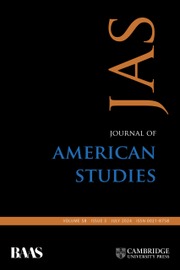As political divisions over immigration policy have deepened, discourse has tended to focus on events at the border, such as the building of a wall or the conditions of detention centres. Yet Jennifer A. Jones's The Browning of the New South is a reminder that arguably more significant developments in immigration policy and enforcement have occurred further inland. This is particularly so in nontraditional immigrant destinations like Winston-Salem, North Carolina, the focus of Jones's work.
This a community-level study, covering the period from 1990 to the present day, which is based on ethnographical research (eighty-six interviews conducted between 2008 and 2009) and an analysis of black, mainstream, and Spanish-language press coverage. This was a period of change. In 1990, Winston-Salem had only a marginal Latino population. Yet by 2008, following years of rapid immigration, Latinos in Forsyth County, where Winston-Salem is located, represented 12.2 percent of the population (46).
For Jones, this period is best understood in two parts. Between 1990 and the mid-2000s, immigrants were broadly welcomed to Winston-Salem. Many obtained long-term employment to support an expanding economy, accessed English-language education, and became members of the community. Though they retained ties to their country of origin, it appeared that Latinos might follow similar acculturation trajectories to other immigrant groups who had been incorporated into mainstream US society. Yet this all changed after 2005, as economic opportunities became more limited and Latinos became subject to increasingly vigorous immigration enforcement methods. Together, this created a culture of suspicion towards Latinos, irrespective of their immigration status.
To explain these trends, The Browning of the New South offers a rich array of concepts. The first of these is the “reverse incorporation trajectory,” whereby “macrostructural shifts produce local-level institutional changes” (68). Cited examples of macrostructural policy changes include the Real ID Act 2005, which tightened regulations for procuring a driver's licence, and the proliferation of Section 287(g) partnerships, which enabled states like North Carolina to assume responsibilities for immigration enforcement. For Jones, these developments show how the post-9/11 state treated immigration as a national security risk. On a local level, this approach resulted in expanded law-enforcement powers, which allowed officers to check anyone's immigration status.
Another concept is “institutional closure” (69), whereby access to education, employment and public services previously available to Latinos was removed. As the climate towards Latinos coarsened in Winston-Salem, the “incorporation gains” (97) of the previous decade were undone, causing downward mobility. Interviews with Latinos revealed that by internalizing this marginalization, there was a process of “racialization,” which resulted in a more distinctive feeling of Latinidad. This stood in contrast to the assimilation processes that previous immigrant groups from Europe had experienced (119).
Finally, Jones explores the concept of “minority linked fate.” Adapting the well-established sociological concept of linked fate, Jones shows how blacks and Latinos in Winston-Salem developed a form of group consciousness and ultimately a shared minority identity. Although this is not to say that Latinos considered their racial identity to be the same as blacks, both perceived themselves as having a shared experience of the city's discriminating practices, as they increasingly became subject to racial profiling by law enforcement following the extension of their immigration enforcement powers. These links were solidified by more positive interpersonal relationships between blacks and Latinos than those they had with whites. An example of minority linked fate was black organizations, such as the local NAACP, conducting forums where blacks and Latinos could express joint positions on key policy issues. Jones uses these experiences to emphasize the importance of considering racial formation as being locally made, based on interpersonal relationships rather than phenotype or existing racial hierarchies.
Using observations in Winston-Salem, Jones offers new perspectives on the literatures of both immigration and racial formation. In particular, Jones challenges the assumption of conflict between black and Latino communities. She argues that the city's Latinos did not engage in the kind of distancing practices used by previous immigrant groups, nor did they avoid minority status to associate with whiteness. In addition, the closeness of the book's events provides insights into the forces that shaped the contemporary moment, as well as the future politics of the New South and the US nationally. Further volumes will need to establish whether the patterns observed in Winston-Salem are consistent throughout the region and beyond, and whether the prospects of a progressive multiracial coalition or white retrenchment discussed by Jones will take hold, but in the meantime this volume has opened several new areas of research for scholars to consider further.


